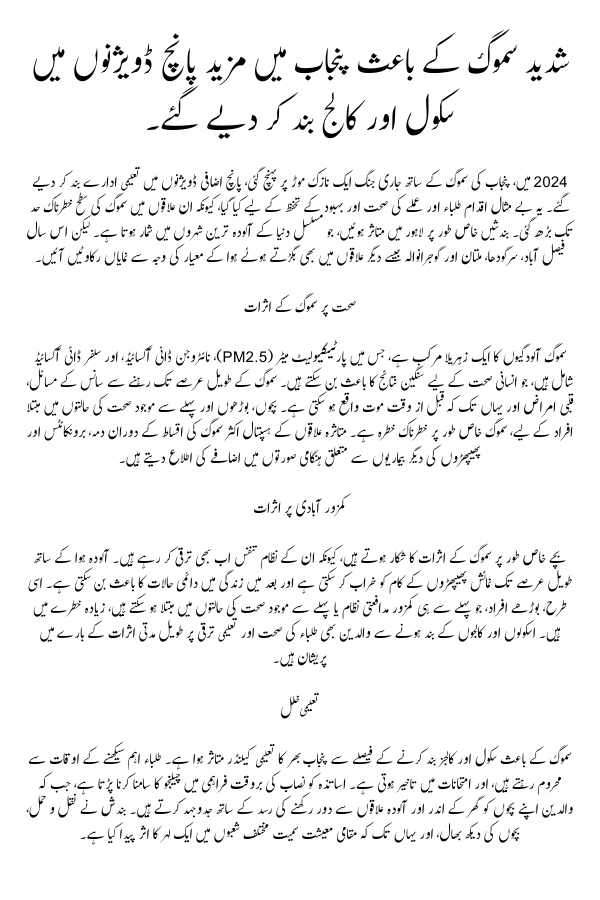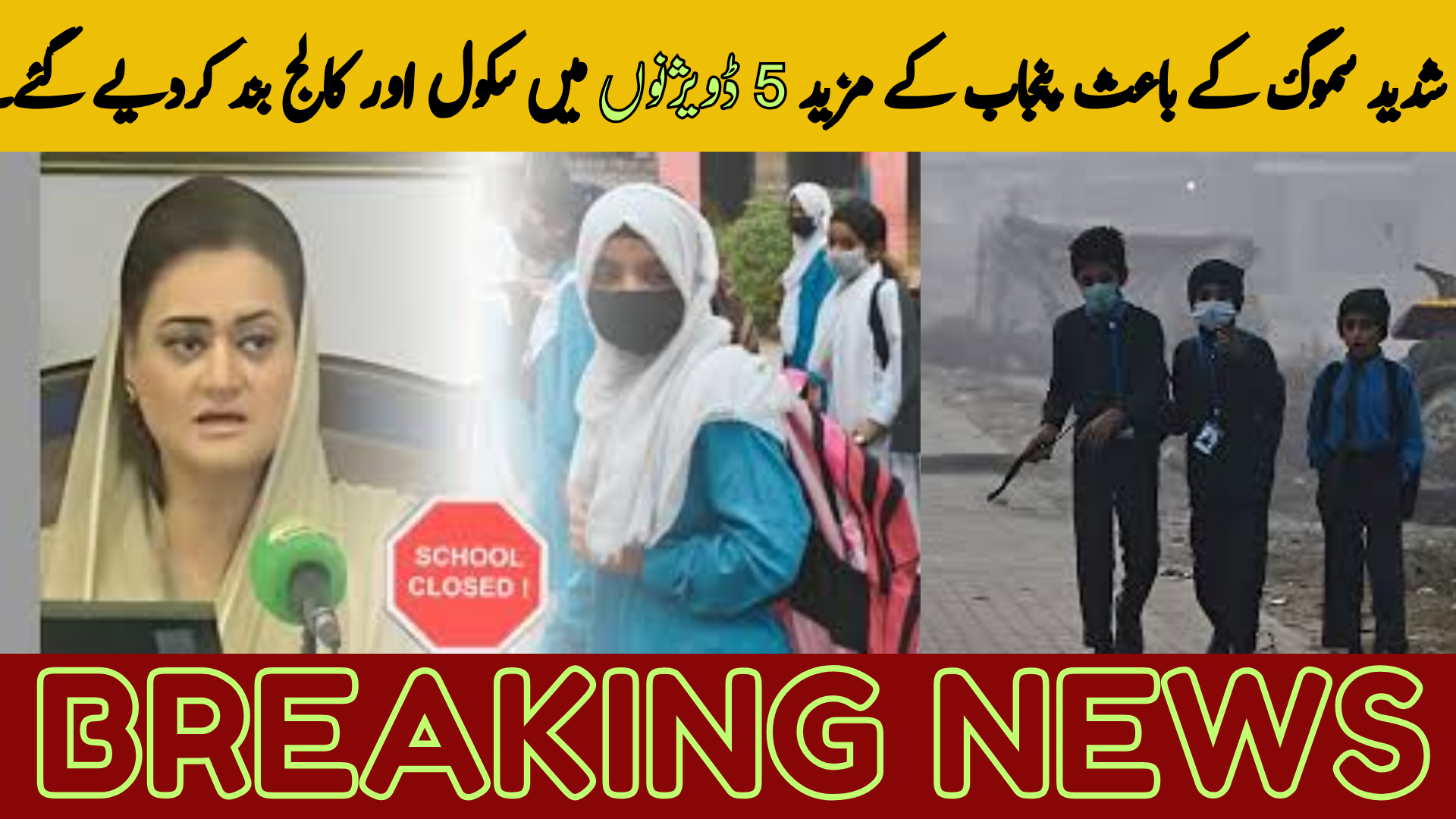Schools and Colleges Closed in Five More Divisions in Punjab Due to Heavy Smog
Punjab’s ongoing battle with smog reached a critical point, with the closure of educational institutions in five additional divisions. This unprecedented move was made to protect the health and well-being of students and staff, as smog levels in these areas soared to hazardous levels. The closures were especially impactful in Lahore, which has consistently ranked among the world’s most polluted cities. But this year, other regions, such as Faisalabad, Sargodha, Multan, and Gujranwala, also experienced significant disruptions due to the deteriorating air quality.
READ MORE:Kissan Cards Across Punjab
Impact of Smog on Health
Smog is a toxic mixture of pollutants, including particulate matter (PM2.5), nitrogen dioxide, and sulfur dioxide, that can have severe consequences for human health. Long-term exposure to smog can cause respiratory problems, cardiovascular diseases, and even premature death. For children, the elderly, and individuals with pre-existing health conditions, smog poses a particularly dangerous threat. Hospitals in affected areas often report an increase in emergency cases related to asthma, bronchitis, and other lung diseases during smog episodes.
Impact on Vulnerable Populations
Children are particularly vulnerable to the effects of smog, as their respiratory systems are still developing. Prolonged exposure to polluted air can impair lung function and lead to chronic conditions later in life. Similarly, elderly individuals, who may already have weakened immune systems or pre-existing health conditions, are at greater risk. With schools and colleges closed, parents are also worried about the long-term impact on students’ health and academic progress.
READ MORE:Using a Kisan Card
Educational Disruption
The decision to close schools and colleges due to smog has disrupted the academic calendar across Punjab. Students miss out on crucial learning hours, and exams are delayed. Teachers face challenges in delivering the curriculum on time, while parents struggle with the logistics of keeping their children indoors and away from polluted areas. The closures have created a ripple effect across various sectors, including transportation, childcare, and even the local economy.
Impact on the Educational System
This recurring problem of smog-related closures could have long-term consequences for the educational system. The interruptions cause significant delays in completing academic coursework, and students may fall behind in their studies. Prolonged school closures also affect mental health, as students are deprived of social interactions and extracurricular activities.

Air Quality Levels and Hazardous Waste Data
Lahore has consistently ranked among the most polluted cities globally, often in the top 10 during smog episodes. The high levels of particulate matter (PM2.5) and other toxic pollutants make the air unhealthy for even short-term exposure. The hazardous waste Punjab Due to Heavy Smog levels in Lahore, primarily due to vehicular emissions, industrial pollutants, and crop burning, exacerbate the city’s smog crisis.
READ MORE:Lives of Marginalized Farmers
Eligibility Criteria
The government has established specific criteria to decide when to close schools and colleges due to smog. If the air quality index (AQI) exceeds 300, schools are typically closed to protect the health of students and staff. Local health authorities monitor the AQI regularly, and if dangerous levels persist for an extended period, closures are declared.
Government and Health Department Guidelines
The Punjab government, in collaboration with the Ministry of Health and environmental agencies, has set guidelines for school closures during smog events. These guidelines are based on air quality forecasts, Punjab Due to Heavy Smog health advisories, and real-time pollution data. Schools are also advised to implement health protocols to minimize risks when air quality is poor but not severe enough to warrant closure.
READ MORE:Benazir Taleemi Wazaif New Payment
Application Process
Local authorities, in consultation with the Environmental Protection Agency (EPA) and health officials, decide whether to close schools based on air quality data. When the air quality reaches hazardous levels, the education department issues an official directive to all schools and colleges in the affected areas. The application process typically involves analyzing data from air quality stations, weather reports, and the number of smog-related health cases in the area.
Role of Air Quality Monitoring and Forecasting
Air quality monitoring stations play a crucial role in determining whether a school closure is necessary. These stations provide real-time data on pollutant levels, helping authorities assess the severity of smog and issue timely warnings. Forecasts are also provided to schools and the public, alerting them to upcoming smog events so they can prepare in advance.
Government Response and Measures
To address the immediate impact of smog, the Punjab government has implemented several short-term measures. These include the temporary closure of schools, public health advisories, and the distribution of face masks. Additionally, certain industrial activities contributing to pollution have been restricted, and truck traffic has been limited during peak smog hours.
READ MORE:Benazir Kafalat Program New Payments
Conclusion
The smog crisis in Punjab, particularly in Lahore, has reached alarming levels, affecting both the environment and public health. With the closure of schools and colleges across several divisions, Punjab Due to Heavy Smog the government has taken a crucial step to safeguard citizens. However, long-term solutions, such as reducing industrial emissions, promoting green transportation, and tackling agricultural practices like crop burning, are essential for mitigating the effects of smog. Citizens also have a role to play by adopting sustainable practices and supporting government initiatives to combat air pollution.
